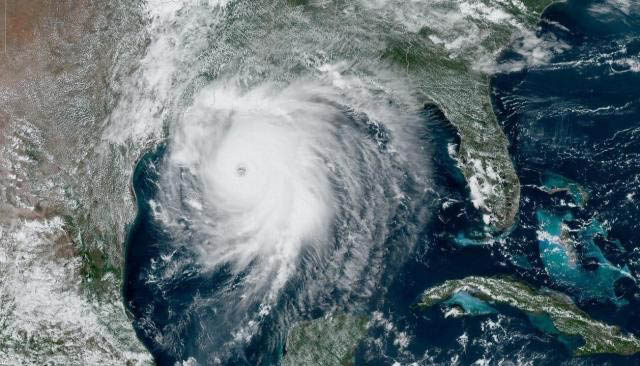PORT ARTHUR, Texas, (Reuters) – Hurricane Laura may be the most powerful storm to crash into the Louisiana coast when it makes landfall in the early hours of today, bringing the potential for catastrophic damage and what forecasters called an “unsurvivable storm surge”.
Laura, located 90 miles (145 km) south-southeast of Port Arthur at 9 p.m. Wednesday, had maximum sustained winds of 150 miles per hour in the hours before landfall, the National Hurricane Center (NHC) said.
Hurricane-level winds could blow as far as 200 miles inland to Shreveport, Louisiana, forecasters said.
The oil-refining town of Port Arthur was directly in Laura’s path, the NHC forecast. The city of 54,000 was a ghost town on Wednesday afternoon, with just a couple of gas stations and a liquor store open for business.
“People need their vodka,” said Janaka Balasooriya, a cashier, who said he lived a few blocks away and would ride out the storm at home.
Forecasters said Laura looked likely to make landfall just east of the Louisiana border with Texas – an area particularly vulnerable to the 20-foot (6-meter) wall of water the hurricane is forecast to blow 40 miles (64 km) inland.
“This is one of the strongest storms to impact that section of coastline,” said David Roth, a forecaster with the National Weather Service. “We worry about that storm surge going so far inland there because it’s basically all marshland north to Interstate 10. There is little to stop the water.”
Just hours before Laura was to smash into the coast, Port Arthur resident Eric Daw hustled to fill up his car at one of the few gas stations still open.
He said he had wanted to evacuate earlier but lacked money for gas as he was waiting on a disability payment. Daw was headed to a shelter in San Antonio, a 4-1/2-hour drive, where instead of worrying about the storm he has to contend with COVID-19, echoing concerns of many others.
“They say we are all supposed to socially distance now,” he said. “But how am I supposed to socially distance in a shelter?”
MANDATORY EVACUATIONS
Some 620,000 people were under mandatory evacuation orders in Louisiana and Texas.
The storm surge could penetrate inland from between Freeport, Texas, and the mouth of the Mississippi River, and could raise water levels as high as 20 feet in parts of Cameron Parish, Louisiana, the NHC said.
“To think that there would be a wall of water over two stories high coming on shore is very difficult for most to conceive, but that is what is going to happen,” said National Weather Service meteorologist Benjamin Schott at a news conference. Most of Louisiana’s Cameron Parish would be under water at some point, Schott added.
“The word ‘unsurvivable’ is not one that we like to use, and it’s one that I’ve never used before,” Schott said of the storm surge.
Temporary housing was being hastily organized outside the surge zone for evacuated residents, and emergency teams were being strategically positioned, state and federal emergency management agencies said.
Federal Emergency Management Agency (FEMA) Administrator Pete Gaynor posted pictures of portable shelters at Camp Beauregard, Louisiana, about 115 miles north of the Gulf Coast.
Texas Governor Greg Abbott said his state’s National Guard was in place with high-water vehicles and rescue helicopters.
While Houston earlier in the week feared that Laura would deliver a direct hit to the fourth-largest U.S. city, the storm has shifted east and Houston, which was devastated by Hurricane Harvey in 2017, looked likely to escape the worst of it.
Louisiana Governor John Bel Edwards said the state’s entire National Guard had been activated for the first time since 2012.
Laura was also expected to spawn tornadoes on Wednesday night over Louisiana, far southeastern Texas and southwestern Mississippi and drop 5 to 10 inches (127 to 254 mm) of rain over the region, the NHC said. It said there would likely be widespread flooding from far eastern Texas across Louisiana and Arkansas from Wednesday to Thursday.
Crude oil production in the Gulf of Mexico has been paralyzed as companies shut down operations. Output cuts are nearing 90%, a level not seen since Hurricane Katrina in 2005.
ENVIRONMENTAL WORRIES
Big hurricanes like Harvey and Katrina have previously wreaked havoc on the oil industry sites dotting the Gulf Coast, where nearly half of the United States’ oil refining capacity is located. There are concerns Laura may do the same.
When Harvey struck in 2017 there were oil and chemical spills, along with heavy air pollution from petrochemical plants and refineries.
“The storm and the direct damage and human life are the most important things, but pollution can be a double whammy and compound the risk to the community,” said Luke Metzger, executive director of Environment Texas.
He urged state agencies to deploy mobile monitors to track pollution following Laura and return the stationary monitors as soon as possible.
The Texas Commission on Environmental Quality, the state’s environmental regulator, said on Wednesday it had shut off 42 stationary monitors because they are not designed to withstand hurricanes.









